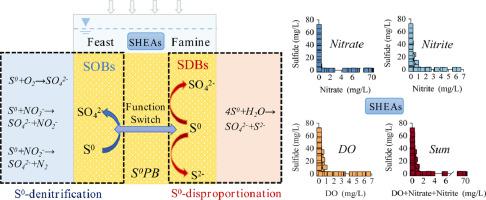Water Research ( IF 11.4 ) Pub Date : 2023-07-14 , DOI: 10.1016/j.watres.2023.120356 Yi-Lu Sun 1 , Si-Yuan Zhai 1 , Zhi-Min Qian 2 , Shan Yi 3 , Wei-Qin Zhuang 4 , Hao-Yi Cheng 2 , Xue-Ning Zhang 1 , Ai-Jie Wang 2

|
Elemental sulfur packed-bed (S0PB) bioreactors for autotrophic denitrification have gained more attention in wastewater treatment due to their organic carbon-free operation, low operating cost, and minimal carbon emissions. However, the rapid development of microbial S0-disproportionation (MS0D) in S0PB reactor during deep denitrification poses a significant drawback to this new technology. MS0D, the process in which sulfur is used as both an electron donor and acceptor by bacteria, plays a crucial role in the microbial-driven sulfur cycle but remains poorly understood in wastewater treatment setups. In this study, we induced MS0D in a pilot-scale S0PB reactor capable of denitrifying over 1000 m3/d nitrate-containing wastewater. Initially, the S0PB reactor stably removed 6.6 mg-NO3−-N/L nitrate at an empty bed contact time (EBCT) of 20 mins, which was designated the S0-denitrification stage. To induce MS0D, we reduced the influent nitrate concentrations to allow deep nitrate removal, resulted in the production of large quantities of sulfate and sulfide (SO42−:S2− 3.2 w/w). Meanwhile, other sulfur-heterologous electron acceptors (SHEAs), e.g., nitrite and DO, were also kept at trace levels. The negative correlations between the SHEAs concentrations and the sulfide productions indicated that the absence of SHEAs was a primary inducing factor to MS0D. The microbial community drastically diverged in response to the depletion of SHEAs during the switch from S0-denitrification to S0-disproportionation. An evident enrichment of sulfur-disproportionating bacteria (SDBs) was found at the S0-disproportionation stage, accompanied by the decline of sulfur-oxidizing bacteria (SOBs). In the end, we discovered that shortening the EBCT and increasing the reflux ratio could inhibit sulfide production by reducing it from 43.9 mg/L to 3.2 mg/L or 25.5 mg/L. In conclusion, our study highlights the importance of considering MS0D when designing and optimizing S0PB reactors for sustainable autotrophic sulfur denitrification in real-life applications.
中文翻译:

在中试规模元素硫填充床生物反应器中管理微生物硫歧化以实现最佳硫自养反硝化
用于自养反硝化的元素硫填充床(S 0 PB)生物反应器由于其无有机碳运行、低运行成本和最小碳排放而在废水处理中受到更多关注。然而,深度反硝化过程中S 0 PB反应器中微生物S 0歧化(MS 0 D)的快速发展给该新技术带来了显着的缺陷。MS 0 D 是细菌将硫用作电子供体和受体的过程,在微生物驱动的硫循环中发挥着至关重要的作用,但在废水处理装置中仍然知之甚少。在本研究中,我们在中试规模的 S 0 PB 反应器中诱导了 MS 0 D ,该反应器能够反硝化超过 1000 m 3 /d 的含硝酸盐废水。最初,S 0 PB反应器在20分钟的空床接触时间(EBCT)下稳定去除了6.6mg-NO 3 - -N/L硝酸盐,这被指定为S 0 -反硝化阶段。为了诱导 MS 0 D,我们降低了进水硝酸盐浓度以深度去除硝酸盐,从而产生大量硫酸盐和硫化物 (SO 4 2− :S 2− 3.2 w/w)。同时,其他硫异源电子受体(SHEA),例如亚硝酸盐和DO,也保持在痕量水平。SHEA 浓度与硫化物产量之间的负相关性表明,SHEA 的缺失是 MS 0 D 的主要诱导因素。在从 S 0反硝化到 S 0的转换过程中,微生物群落因 SHEA 的耗尽而发生了巨大的分化。 -比例失调。在S 0歧化阶段发现硫歧化细菌(SDBs)明显富集,同时硫氧化细菌(SOBs)减少。最终,我们发现缩短EBCT和增加回流比可以抑制硫化物的产生,将其从43.9 mg/L降低到3.2 mg/L或25.5 mg/L。总之,我们的研究强调了在设计和优化 S 0 PB 反应器以实现现实应用中可持续自养硫脱氮作用时考虑 MS 0 D的重要性。































 京公网安备 11010802027423号
京公网安备 11010802027423号